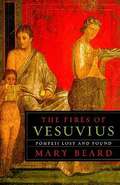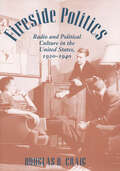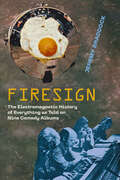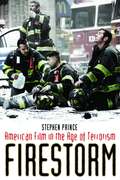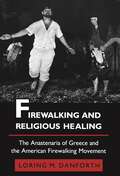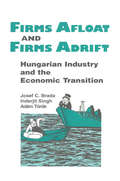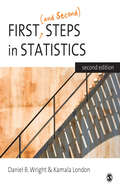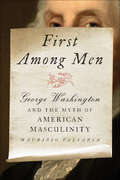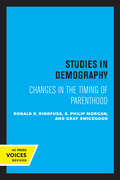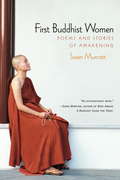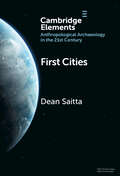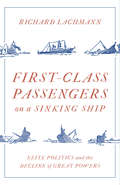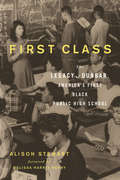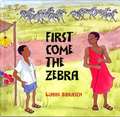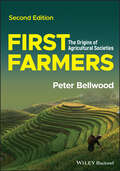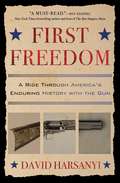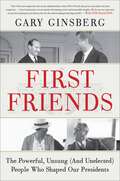- Table View
- List View
Fires of Gold: Law, Spirit, and Sacrificial Labor in Ghana (Atelier: Ethnographic Inquiry in the Twenty-First Century #4)
by Lauren Coyle RosenFires of Gold is a powerful ethnography of the often shrouded cultural, legal, political, and spiritual forces governing the gold mining industry in Ghana, one of Africa’s most celebrated democracies. Lauren Coyle Rosen argues that significant sources of power have arisen outside of the formal legal system to police, adjudicate, and navigate conflict in this theater of violence, destruction, and rebirth. These authorities, or shadow sovereigns, include the transnational mining company, collectivized artisanal miners, civil society advocacy groups, and significant religious figures and spiritual forces from African, Islamic, and Christian traditions. Often more salient than official bodies of government, the shadow sovereigns reveal a reconstitution of sovereign power—one that, in many ways, is generated by hidden dimensions of the legal system. Coyle Rosen also contends that spiritual forces are central in anchoring and animating shadow sovereigns as well as key forms of legal authority, economic value, and political contestation. This innovative book illuminates how the crucible of gold, itself governed by spirits, serves as a critical site for embodied struggles over the realignment of the classical philosophical triad: the city, the soul, and the sacred.
Fires of Vesuvius: Pompeii Lost and Found
by Mary BeardThis book shows us how much more and less there is to Pompeii than a city frozen in time as it went about its business on 24 August 79.
Fires on the Border: The Passionate Politics of Labor Organizing on the Mexican Frontera
by Rosemary HennessyThe history of the maquiladoras has been punctuated by workers&’ organized resistance to abysmal working and living conditions. Over years of involvement in such movements, Rosemary Hennessy was struck by an elusive but significant feature of these struggles: the extent to which organizing is driven by attachments of affection and antagonism, belief, betrayal, and identification.What precisely is the &“affective&” dimension of organizing for justice? Are affects and emotions the same? And how can their value be calculated? Fires on the Border takes up these questions of labor and community organizing—its &“affect-culture&”—on Mexico&’s northern border from the early 1970s to the present day. Through these campaigns, Hennessy illuminates the attachments and identifications that motivate people to act on behalf of one another and that bind them to a common cause. The book&’s unsettling, even jarring, narratives bring together empirical and ethnographic accounts—of specific campaigns, the untold stories of gay and lesbian organizers, love and utopian longing—in concert with materialist theories of affect and the critical good sense of Mexican organizers. Teasing out the integration of affect-culture in economic relations and cultural processes, Hennessy provides evidence that sexuality and gender as strong affect attractors are incorporated in the harvesting of surplus labor. At the same time, workers&’ testimonies confirm that the capacities for bonding and affective attachment, far from being entirely at the service of capital, are at the very heart of social movements devoted to sustaining life.
Fireside Politics: Radio and Political Culture in the United States, 1920–1940 (Reconfiguring American Political History)
by Douglas B. CraigAn “impressively researched and useful study” of the golden age of radio and its role in American democracy (Journal of American History).In Fireside Politics, Douglas B. Craig provides the first detailed and complete examination of radio’s changing role in American political culture between 1920 and 1940—the medium’s golden age, when it commanded huge national audiences without competition from television.Craig follows the evolution of radio into a commercialized, networked, and regulated industry, and ultimately into an essential tool for winning political campaigns and shaping American identity in the interwar period. Finally, he draws thoughtful comparisons of the American experience of radio broadcasting and political culture with those of Australia, Britain, and Canada.“The best general study yet published on the development of radio broadcasting during this crucial period when key institutional and social patterns were established.” ?Technology and Culture
Fireside Tales of the Traveller Children: Twelve Scottish Stories
by Duncan WilliamsonFireside Tales of the Traveller Children is a carefully chosen selection from Duncan Williamson's seemingly endless repertoire. Here are tales of ghosts and selkies, speywives and witches. Many of the tales have familiar themes.
Firesign: The Electromagnetic History of Everything as Told on Nine Comedy Albums
by Jeremy BraddockA cultural clearinghouse of the American 1960s and '70s told through the story of the period's most important forgotten comedy group. This expansive book reclaims the Firesign Theatre (hazily remembered as a comedy act for stoners) as critically engaged artists working in the heart of the culture industry at a time of massive social and technological change. At the intersection of popular music, sound and media studies, cultural history, and avant-garde literature, Jeremy Braddock explores how this inventive group made the lowbrow comedy album a medium for registering the contradictions and collapse of the counterculture, and traces their legacies in hip-hop turntablism, computer hacking, and participatory fan culture. He deploys a vast range of material sources, drawing on numerous interviews and writing in tune with the group's obsessive and ludic reflections—on multitrack recording, radio, television, cinema, early artificial intelligence, and more—to focus on Firesign's work in Los Angeles from 1967 to 1975. This ebullient act of media archaeology reveals Firesign Theatre as authors of a comic utopian pessimism that will inspire twenty-first-century recording arts and urge us to engage the massive technological changes of our own era.
Firestorm: American Film in the Age of Terrorism
by Stephen PrinceIt was believed that September 11th would make certain kinds of films obsolete, such as action thrillers crackling with explosions or high-casualty blockbusters where the hero escapes unscathed. While the production of these films did ebb, the full impact of the attacks on Hollywood's creative output is still taking shape. Did 9/11 force filmmakers and screenwriters to find new methods of storytelling? What kinds of movies have been made in response to 9/11, and are they factual? Is it even possible to practice poetic license with such a devastating, broadly felt tragedy? Stephen Prince is the first scholar to trace the effect of 9/11 on the making of American film. From documentaries like Fahrenheit 9/11 (2004) to zombie flicks, and from fictional narratives such as The Kingdom (2007) to Mike Nichols's Charlie Wilson's War (2007), Prince evaluates the extent to which filmmakers have exploited, explained, understood, or interpreted the attacks and the Iraq War that followed, including incidents at Abu Ghraib. He begins with pre-9/11 depictions of terrorism, such as Alfred Hitchcock's Sabotage (1936), and follows with studio and independent films that directly respond to 9/11. He considers documentary portraits and conspiracy films, as well as serial television shows (most notably Fox's 24) and made-for-TV movies that re-present the attacks in a broader, more intimate way. Ultimately Prince finds that in these triumphs and failures an exciting new era of American filmmaking has taken shape.
Firestorm: American Film in the Age of Terrorism
by Stephen PrinceIt was believed that September 11th would make certain kinds of films obsolete, such as action thrillers crackling with explosions or high-casualty blockbusters where the hero escapes unscathed. While the production of these films did ebb, the full impact of the attacks on Hollywood's creative output is still taking shape. Did 9/11 force filmmakers and screenwriters to find new methods of storytelling? What kinds of movies have been made in response to 9/11, and are they factual? Is it even possible to practice poetic license with such a devastating, broadly felt tragedy?Stephen Prince is the first scholar to trace the effect of 9/11 on the making of American film. From documentaries like Fahrenheit 9/11 (2004) to zombie flicks, and from fictional narratives such as The Kingdom (2007) to Mike Nichols's Charlie Wilson's War (2007), Prince evaluates the extent to which filmmakers have exploited, explained, understood, or interpreted the attacks and the Iraq War that followed, including incidents at Abu Ghraib. He begins with pre-9/11 depictions of terrorism, such as Alfred Hitchcock's Sabotage (1936), and follows with studio and independent films that directly respond to 9/11. He considers documentary portraits and conspiracy films, as well as serial television shows (most notably Fox's 24) and made-for-TV movies that re-present the attacks in a broader, more intimate way. Ultimately Prince finds that in these triumphs and failures an exciting new era of American filmmaking has taken shape.
Firewalking and Religious Healing: The Anastenaria of Greece and the American Firewalking Movement (Princeton Modern Greek Studies #2)
by Loring M. Danforth"If the Saint calls you, if you have an open road, then you don't feel the fire as if it were your enemy," says one of the participants in the Anastenaria. This compelling work evokes and contrasts two forms of firewalking and religious healing: first, the Anastenaria, a northern Greek ritual in which people who are possessed by Saint Constantine dance dramatically over red-hot coals, and, second, American firewalking, one of the more spectacular activities of New Age psychology. Loring Danforth not only analyzes these rituals in light of the most recent work in medical and symbolic anthropology but also describes in detail the lives of individual firewalkers, involving the reader personally in their experiences: he views ritual therapy as a process of transformation and empowerment through which people are metaphorically moved from a state of illness to a state of health. Danforth shows that the Anastenaria and the songs accompanying it allow people to express and resolve conflict-laden family relationships that may lead to certain kinds of illnesses. He also demonstrates how women use the ritual to gain a sense of power and control over their lives without actually challenging the ideology of male dominance that pervades Greek culture. Comparing the Anastenaria with American firewalking, Danforth includes a gripping account of his own participation in a firewalk in rural Maine. Finally he examines the place of anthropology in a postmodern world in which the boundaries between cultures are becoming increasingly blurred.
Firewater and Forked Tongues: A Sioux Chief Interprets American History
by M. I. McCreightAs a dedicated Native American advocate since the age of 20, author Major Israel McCreight saw the sad plight of the Indians in the period following the Custer Fight and the Battle of Wounded Kane.This book, first published in 1947, is the account of the versions of U.S. history according to the old Sioux Chief, FLYING HAWK. Flying Hawk, who was a nephew of Sitting Bull and fought with Crazy Horse at Little Big Horn, dictated his narrative to McCreight, thus making this an account not from the perspective of “the white man”—but as it really happened…A fascinating read!
Fireweed: A Political Autobiography
by Gerda LernerAutobiography of pioneering women's historian focusing on her youth in Austria, escape from the Nazis involvement in radical politics and emigration to the U.S.
Firms Afloat and Firms Adrift: Hungarian Industry and Economic Transition
by Inderjit Singh Joseph C. Brada Aadaam TeoreokDesigned for various types of college courses, this book discusses the interpretation of statistical data in such fields as the economy, business, demography, housing, health, education and crime.
First (and Second) Steps in Statistics
by Daniel B. Wright Kamala London'This engagingly written and nicely opinionated book is a blend of friendly introduction and concisely applicable detail. No-one can recall every statistical formula, but if they have this book they will know where to look' - Professor Jon May, University of Plymouth 'This is one of the best books I have come across for teaching introductory statistics. The illustrative examples are engaging and often humorous and the explanations of 'difficult' concepts are written in a wonderfully clear and intuitive way' - Nick Allum, University of Essex Selected as an Outstanding Academic Title by Choice Magazine, January 2010 First (and Second) Steps in Statistics, Second Edition provides a clear and concise introduction to the main statistical procedures used in the social and behavioural sciences and is perfect for the statistics student starting their journey. The rationale and procedure for analyzing data are presented through exciting examples with an emphasis on understanding rather than computation. It is ideally suited for introductory courses in statistics given its gentle beginning, yet progressive treatment of topics. In addition to descriptive statistics, graphs, t-tests, oneway ANOVAs, Chi-square, and simple linear regression, this Second Edition now includes some new, more advanced topic areas as well as a host of additional examples to help students confidently progress through their studies and apply the techniques in lab work, reports and research projects. Key features of this new edition: - the reoganization of the first three chapters giving more attention to univariate statistics and providing more examples to work through at this level - more advanced 'second step' content has been added on factorial ANOVA and multiple regression - the robust methods chapter from the first edition is now spread throughout the book, and is linked with common teaching practices. - many more examples have been added to enhance the book's practical potential. - a host of exercises as well as further reading sections at the end of every chapter. An accompanying Web page includes information for each chapter using the statistical packages SPSS and R.
First Americans: U.S. Patriotism in Indian Country after World War I
by Thomas GrillotThe little-known story of how army veterans returning to reservation life after World War I transformed Native American identity. Drawing from archival sources and oral histories, Thomas Grillot demonstrates how the relationship between Native American tribes and the United States was reinvented in the years following World War I. During that conflict, twelve thousand Native American soldiers served in the U.S. Army. They returned home to their reservations with newfound patriotism, leveraging their veteran cachet for political power and claiming all the benefits of citizenship—even supporting the termination policy that ended the U.S. government&’s recognition of tribal sovereignty.
First Among Men: George Washington and the Myth of American Masculinity
by Maurizio ValsaniaDispelling common myths about the first US president and revealing the real George Washington.George Washington—hero of the French and Indian War, commander in chief of the Continental Army, and first president of the United States—died on December 14, 1799. The myth-making began immediately thereafter, and the Washington mythos crafted after his death remains largely intact. But what do we really know about Washington as an upper-class man?Washington is frequently portrayed by his biographers as America at its unflinching best: tall, shrewd, determined, resilient, stalwart, and tremendously effective in action. But this aggressive and muscular version of Washington is largely a creation of the nineteenth century. Eighteenth-century ideals of upper-class masculinity would have preferred a man with refined aesthetic tastes, graceful and elegant movements, and the ability and willingness to clearly articulate his emotions. At the same time, these eighteenth-century men subjected themselves to intense hardship and inflicted incredible amounts of violence on each other, their families, their neighbors, and the people they enslaved. In First Among Men: George Washington and the Myth of American Masculinity, Valsania considers Washington's complexity and apparent contradictions in three main areas: his physical life (often bloody, cold, injured, muddy, or otherwise unpleasant), his emotional world (sentimental, loving, and affectionate), and his social persona (carefully constructed and maintained). In each, he notes, the reality diverges from the legend quite drastically. Ultimately, Valsania challenges readers to reconsider what they think they know about Washington.Aided by new research, documents, and objects that have only recently come to light, First Among Men tells the fascinating story of a living and breathing person who loved, suffered, moved, gestured, dressed, ate, drank, and had sex in ways that may be surprising to many Americans. In this accessible, detailed narrative, Valsania presents a full, complete portrait of Washington as readers have rarely seen him before: as a man, a son, a father, and a friend.
First Available Cell
by James W. Marquart Chad R. Trulson Ben M. CrouchDecades after the U. S. Supreme Court and certain governmental actions struck down racial segregation in the larger society, American prison administrators still boldly adhered to discriminatory practices. Not until 1975 did legislation prohibit racial segregation and discrimination in Texas prisons. However, vestiges of this practice endured behind prison walls. Charting the transformation from segregation to desegregation in Texas prisons—which resulted in Texas prisons becoming one of the most desegregated places in America—First Available Cell chronicles the pivotal steps in the process, including prison director George J. Beto’s 1965 decision to allow inmates of different races to co-exist in the same prison setting, defying Southern norms. The authors also clarify the significant impetus for change that emerged in 1972, when a Texas inmate filed a lawsuit alleging racial segregation and discrimination in the Texas Department of Corrections. Perhaps surprisingly, a multiracial group of prisoners sided with the TDC, fearing that desegregated housing would unleash racial violence. Members of the security staff also feared and predicted severe racial violence. Nearly two decades after the 1972 lawsuit, one vestige of segregation remained in place: the double cell. Revealing the aftermath of racial desegregation within that 9 x 5 foot space, First Available Cell tells the story of one of the greatest social experiments with racial desegregation in American history.
First Births in America: Changes in the Timing of Parenthood (Studies in Demography #2)
by S. Philip Morgan Ronald R. Rindfuss C Gray SwicegoodThis title is part of UC Press's Voices Revived program, which commemorates University of California Press’s mission to seek out and cultivate the brightest minds and give them voice, reach, and impact. Drawing on a backlist dating to 1893, Voices Revived makes high-quality, peer-reviewed scholarship accessible once again using print-on-demand technology. This title was originally published in 1988.
First Buddhist Women
by Susan MurcottFirst Buddhist Women is a readable, contemporary translation of and commentary on the enlightenment verses of the first female disciples of the Buddha. Through the study of the Therigatha, the earliest-known collection of women's religious poetry, the book explores Buddhism's 2,600-year-long liberal attitude toward women. Utilizing commentary and storytelling, author Susan Murcott traces the journey of wives, mothers, teachers, courtesans, prostitutes, and wanderers who became leaders in the Buddhist community, acquiring roles that even today are rarely filled by women in other, patriarchal religions.
First Cities: Planning Lessons for the 21st Century (Elements in Anthropological Archaeology in the 21st Century)
by Dean SaittaThis Element describes and synthesizes archaeological knowledge of humankind's first cities for the purpose of strengthening a comparative understanding of urbanism across space and time. Case studies are drawn from ancient Mesopotamia, Europe, Asia, Africa, and the Americas. They cover over 9000 years of city building. Cases exemplify the 'deep history' of urbanism in the classic heartlands of civilization, as well as lesser-known urban phenomena in other areas and time periods. The Element discusses the relevance of this knowledge to a number of contemporary urban challenges around food security, service provision, housing, ethnic co-existence, governance, and sustainability. This study seeks to enrich scholarly debates about the urban condition, and inspire new ideas for urban policy, planning, and placemaking in the twenty first century.
First Class Passengers on a Sinking Ship: Elite Politics and the Decline of Great Powers
by Richard LachmannA history of why great powers decline, from Spain to the United StatesThe extent and irreversibility of US decline is becoming ever more obvious as America loses war after war and as one industry after another loses its technological edge. Lachmann explains why the United States will not be able to sustain its global dominance, and contrasts America's relatively brief period of hegemony with the Netherlands' similarly short primacy and Britain's far longer era of leadership.Decline in all those cases was not inevitable and did not respond to global capitalist cycles. Rather, decline is the product of elites' success in grabbing control over resources and governmental powers. Not only are ordinary people harmed, but also capitalists become increasingly unable to coordinate their interests and adopt policies and make investments necessary to counter economic and geopolitical competitors elsewhere in the world.Conflicts among elites and challenges by non-elites determine the timing and mold the contours of decline. Lachmann traces the transformation of US politics from an era of elite consensus to present-day paralysis combined with neoliberal plunder, explains the paradox of an American military with an unprecedented technological edge unable to subdue even the weakest enemies, and the consequences of finance's cannibalization of the US economy.
First Class: The Legacy of Dunbar, America’s First Black Public High School
by Alison Stewart Melissa Harris-PerryCombining a fascinating history of the first U.S. high school for African Americans with an unflinching analysis of urban public-school education today, First Class explores an underrepresented and largely unknown aspect of black history while opening a discussion on what it takes to make a public school successful. In 1870, in the wake of the Civil War, citizens of Washington, DC, opened the Preparatory High School for Colored Youth, the first black public high school in the United States; it would later be renamed Dunbar High and would flourish despite Jim Crow laws and segregation. Dunbar attracted an extraordinary faculty: its early principal was the first black graduate of Harvard, and at a time it had seven teachers with PhDs, a medical doctor, and a lawyer. During the school's first 80 years, these teachers would develop generations of highly educated, successful African Americans, and at its height in the 1940s and '50s, Dunbar High School sent 80 percent of its students to college. Today, as in too many failing urban public schools, the majority of Dunbar students are barely proficient in reading and math. Journalist and author Alison Stewart--whose parents were both Dunbar graduates--tells the story of the school's rise, fall, and possible resurgence as it looks to reopen its new, state-of-the-art campus in the fall of 2013.
First Come The Zebra
by Lynne BaraschWhen Abaani, a Maasai boy, takes his family's cattle out to graze, he is suprised to see a Kikuyu boy, Haki, tending a new fruit and vegetable stall alongside the road. Aware of the traditional conflict between the Maasai and the Kikuyu, the boys take an immediate dislike to each other. A short while later, as customers surround Haki's stall, a dangerous situation arises - and as the boys act together to confront the danger, they also take the first step in overcoming their differences and becoming friends.
First Farmers: The Origins of Agricultural Societies
by Peter BellwoodA wide-ranging and accessible introduction to the origins and histories of the first agricultural populations in many different parts of the world This fully revised and updated second edition of First Farmers examines the origins of food production across the world and documents the expansions of agricultural populations from source regions during the past 12,000 years. It commences with the archaeological records from the multiple homelands of agriculture, and extends into discussions that draw on linguistic and genomic information about the human past, featuring new findings from the last ten years of research. Through twelve chapters, the text examines the latest evidence and leading theories surrounding the early development of agricultural practices through data drawn from across the anthropological discipline—primarily archaeology, comparative linguistics, and biological anthropology—to present a cohesive history of early farmer migration. Founded on the author's insights from his research into the agricultural prehistory of East and Southeast Asia—one of the best focus areas for the teaching of prehistoric archaeology—this book offers an engaging account of how prehistoric humans settled new landscapes. The second edition has been thoroughly updated with many new maps and illustrations that reflect the multidisciplinary knowledge of the present day. Authored by a leading scholar with wide-ranging experience across the fields of anthropology and archaeology, First Farmers, Second Edition includes information on: The early farming dispersal hypothesis in current perspective, plus operational considerations regarding the origins and dispersals of agriculture The archaeological evidence for the origins and spreads of agriculture in the Eurasian, African and American continents The histories of the language families that spread with the first farming populations, and the evidence from biological anthropology and ancient DNA that underpins our modern knowledge of these migrations Drawing evidence from across the sub-disciplines of anthropology to present a cohesive and exciting analysis of an important subject in the study of human population history, Farmers First, Second Edition is an important work of scholarship and an excellent introduction to multiple methods of anthropological and archaeological inquiry for the beginner student in prehistoric anthropology and archaeology, human migration, archaeology of East and Southeast Asia, agricultural history, comparative anthropology, and more disciplines across the anthropology curriculum.
First Freedom: A Ride Through America's Enduring History with the Gun
by David HarsanyiFrom “one of America’s smartest political writers” (Glenn Beck) comes a fascinating and accessible history of the United States’ unique and enduring relationship with guns, for fans of Chris Kyle’s American Gun.For America, the gun is a story of innovation, power, violence, character, and freedom. From the founding of the nation to the pioneering of the West, from the freeing of the slaves to the urbanization of the twentieth century, our country has had a complex and lasting relationship with firearms. Now, in First Freedom, nationally syndicated columnist and veteran writer David Harsanyi explores the ways in which firearms have helped preserve our religious, economic, and cultural institutions for over two centuries. From Samuel Colt’s early entrepreneurism to the successful firearms technology that helped make the United States a superpower, the gun is inextricably tied to our exceptional rise. In the vein of popular histories like Salt and Seabiscuit, Harsanyi takes you on a captivating and thrilling ride of Second Amendment history that demonstrates why guns are not only an integral part of America’s past, but also an essential part of its future.
First Friends: The Powerful, Unsung (And Unelected) People Who Shaped Our Presidents
by Gary GinsbergIn the bestselling tradition of The Presidents Club and Presidential Courage, White House history as told through the stories of the best friends and closest confidants of American presidents. <P><P> Here are the riveting histories of myriad presidential friendships, among them: <br>Abraham Lincoln and Joshua Speed: They shared a bed for four years during which Speed saved his friend from a crippling depression. Two decades later the friends worked together to save the Union. <br>Harry Truman and Eddie Jacobson: When Truman wavered on whether to recognize the state of Israel in 1948, his lifelong friend and former business partner intervened at just the right moment with just the right words to steer the president’s decision. <br>Franklin Delano Roosevelt and Daisy Suckley: Unassuming and overlooked during her lifetime, Daisy Suckley was in reality FDR’s most trusted, constant confidant, the respite for a lonely and overworked President navigating the Great Depression and World War II <br>John Kennedy and David Ormsby-Gore: They met as young men in pre-war London and began a conversation over the meaning of leadership. A generation later the Cuban Missile Crisis would put their ideas to test as Ormsby-Gore became the president’s unofficial, but most valued foreign policy advisor. <P><P> These and other friendships—including Thomas Jefferson and James Madison, Franklin Pierce and Nathaniel Hawthorne, and Bill Clinton and Vernon Jordan—populate this fresh and provocative exploration of a series of seminal presidential friendships. <P><P> Publishing history teems with books by and about Presidents, First Ladies, First Pets, and even First Chefs. Now former Clinton aide Gary Ginsberg breaks new literary ground on Pennsylvania Avenue and provides fresh insights into the lives of the men who held the most powerful political office in the world by looking at the friends on whom they relied. <P><P>First Friends is an engaging, serendipitous look into the lives of Commanders-in-Chief and how their presidencies were shaped by those they held most dear. <P><P><b>A New York Times Best Seller</b>

